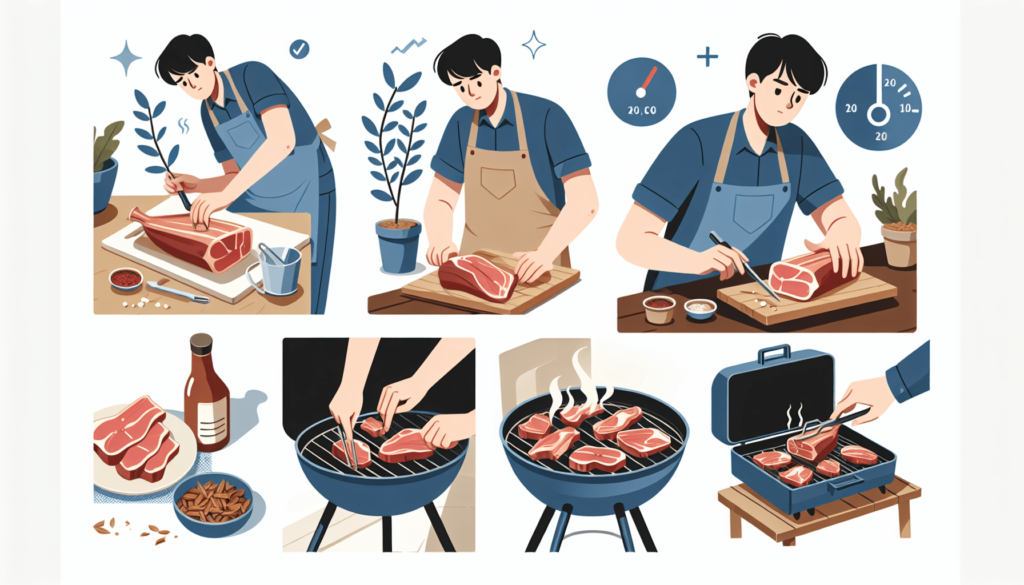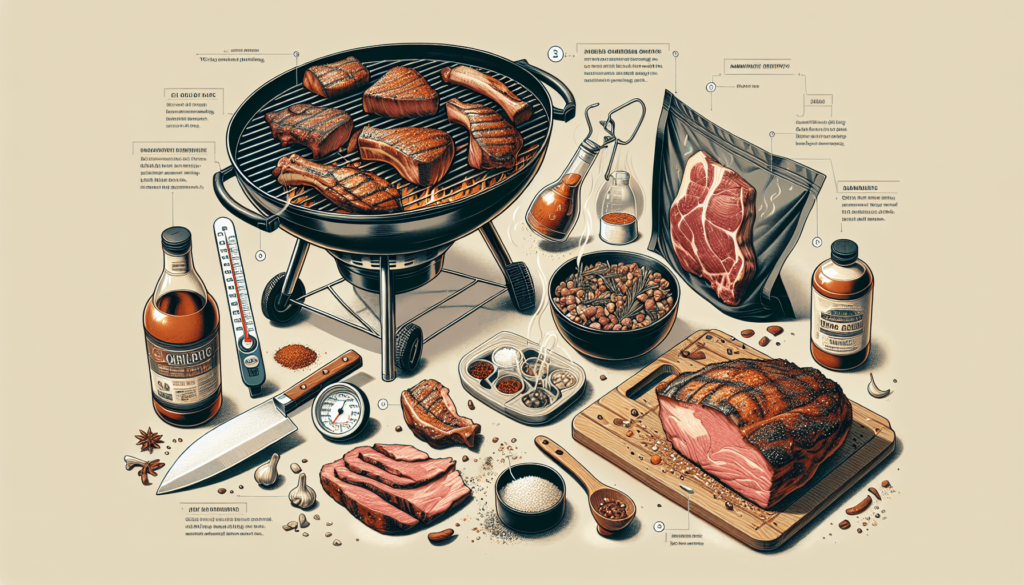If you’re looking to elevate your BBQ game, mastering the art of low and slow cooking is a must. Whether you’re a seasoned grill master or just starting out, these tips will help you achieve tender, flavorful meats that will have your guests coming back for seconds. From choosing the right wood and mastering temperature control to selecting the perfect cuts of meat, this guide will take you through everything you need to know to become a low and slow BBQ cooking expert. So dust off your smoker, grab your tongs, and get ready to take your BBQ skills to the next level.

Choosing the Right Cut of Meat
When it comes to low and slow BBQ cooking, choosing the right cut of meat is crucial. The first thing you should consider is the fat content. Fat adds flavor and helps keep the meat moist during the long cooking process. Look for cuts with good marbling, as this indicates a higher fat content. Some popular cuts for BBQ cooking include brisket, pork shoulder, ribs, and beef short ribs. Each of these cuts has its own unique flavor and texture when cooked low and slow, so don’t be afraid to experiment and find your favorite.
Preparing the Meat
Before you start cooking, it’s important to properly prepare the meat. One essential step is trimming excess fat. While fat adds flavor, excessive amounts can prevent the meat from absorbing the smoke and seasonings evenly. Take a sharp knife and trim any large chunks of fat, being careful not to cut into the meat itself.
Seasoning the meat ahead of time is another vital step. This allows the flavors to penetrate deep into the meat, resulting in a more flavorful end product. You can use a dry rub or a marinade, depending on your preference. Make sure to generously coat the meat and let it sit in the refrigerator for a few hours or even overnight to enhance the flavors.
Lastly, it’s important to let the meat rest at room temperature before cooking. Allowing the meat to come to room temperature helps it cook more evenly and prevents it from becoming dry. Simply take the meat out of the refrigerator about 30 minutes before you plan to start cooking.
Creating the Perfect Fire
The fire is the heart of any BBQ cooking process, and creating the perfect fire is essential for low and slow cooking. Instead of using regular charcoal briquettes, opt for hardwood charcoal or wood chunks. These burn hotter and longer, providing a more consistent heat source throughout the cooking process.
To arrange the charcoal for indirect heat, create two zones in your grill or smoker. Place the charcoal on one side, allowing the heat to radiate towards the other side where the meat will be placed. This indirect heat method helps to cook the meat evenly and prevents it from burning.
Maintaining a consistent temperature is key in low and slow BBQ cooking. To achieve this, consider using a charcoal chimney. This tool allows you to preheat the charcoal before adding it to the grill, ensuring a more controlled and even temperature throughout the cooking process.
Setting Up the Smoker or Grill
Now that you have your fire ready, it’s time to set up your smoker or grill. Start by cleaning and prepping the smoker or grill to ensure a clean cooking surface. Remove any ashes or debris from previous uses, and make sure the grates are clean and free from stuck-on food.
To add flavor to your BBQ, consider using soaked wood chips or chunks. Soaking the wood helps create smoke, which infuses the meat with a delicious smoky flavor. Place the soaked wood chips or chunks directly on top of the charcoal or in a separate smoker box if your grill has one.
To keep the meat moist during the cooking process, place a water pan under the meat. The water in the pan will evaporate, creating a moist environment inside the smoker or grill. This moisture helps prevent the meat from drying out, resulting in a juicy and tender end product.

Monitoring and Controlling Temperature
Temperature control is crucial when cooking low and slow. Investing in a digital meat thermometer is highly recommended. This type of thermometer provides accurate readings and helps ensure your meat is cooked to the perfect temperature. Insert the thermometer into the thickest part of the meat, away from bones or fat, to get the most accurate reading.
To regulate airflow and temperature, utilize the vents on your smoker or grill. Adjusting the vents allows you to increase or decrease the airflow, which in turn affects the temperature inside the cooking chamber. Start with the vents partially open and make adjustments as needed to maintain a consistent temperature throughout the cooking process.
Patience is Key
When it comes to low and slow BBQ cooking, patience is key. It can be tempting to constantly lift the lid to check on the progress of your meat, but resist that urge. Opening the lid too often can cause fluctuations in temperature, resulting in uneven cooking. Trust the process and resist the temptation to peek until you believe the meat is ready.
Maintaining a consistent temperature throughout the cooking process is crucial. Fluctuations in temperature can result in undercooked or overcooked meat. Keep a close eye on the thermometer and make adjustments to the vents as needed to maintain a steady temperature.
Allowing the meat to cook slowly until tender is essential for achieving that perfect BBQ texture. Low and slow cooking breaks down the connective tissues in the meat, resulting in succulent and tender bites. It may take several hours, depending on the cut of meat and size, so be patient and enjoy the process.
Mopping and Basting
Mopping and basting are techniques used to add extra flavor and moisture to the meat during the cooking process. Mops and basting sauces are typically made with a combination of flavorful ingredients such as vinegar, spices, and oils.
Apply the mop or basting sauce to the meat using a brush or spray bottle. Make sure to do this at regular intervals to keep the meat moist and infuse it with additional flavors. As the meat cooks, continue to mop or baste to build up layers of flavor.
When applying the mop or basting sauce, make sure to use a clean brush or spray bottle to prevent cross-contamination. You don’t want to introduce any harmful bacteria to your delicious BBQ.
Wrapping and Resting the Meat
Wrapping the meat is another technique that can help enhance the tenderness and juiciness of your BBQ. It’s commonly done during the cooking process to retain moisture and prevent the meat from drying out. Foil or butcher paper can be used for wrapping.
To wrap the meat, simply place it on a sheet of foil or butcher paper and tightly wrap it, sealing in the juices. The wrapped meat should then be placed back in the smoker or grill to continue cooking until it reaches the desired tenderness.
After the meat is done cooking, it’s crucial to let it rest for at least 30 minutes. Resting allows the juices to redistribute within the meat, resulting in a juicier and more tender final product. Simply remove the meat from the smoker or grill and let it rest on a cutting board or plate covered with foil.
Serving and Enjoying the BBQ
Finally, it’s time to savor the rewards of your low and slow BBQ cooking. When slicing the meat, make sure to cut against the grain for maximum tenderness. Cutting against the grain helps break up the muscle fibers, resulting in a more tender and easier-to-chew final product.
Serve your BBQ with your favorite BBQ sauce or dry rub. Whether you prefer a tangy and sweet sauce or a spicy dry rub, the choice is yours. The sauce or rub will add an extra layer of flavor to your perfectly cooked meat.
To complete the BBQ experience, pair your deliciously smoked meat with some mouthwatering side dishes. Classic options like coleslaw, macaroni and cheese, baked beans, and cornbread are always crowd-pleasers. Don’t forget to grab a refreshing beverage to wash it all down.
Experimentation and Practice
Mastering low and slow BBQ cooking takes time, experimentation, and practice. To add unique flavors to your BBQ, try different wood flavors such as apple, cherry, hickory, or mesquite. Each wood imparts its own distinct smoky taste, allowing you to customize your BBQ experience.
Cooking times and temperatures may vary depending on the thickness of the meat and other factors. It’s essential to adjust the cooking times and temperatures accordingly to achieve the desired results. Keep track of your successes and improvements by maintaining a BBQ journal. This will allow you to replicate your successful recipes and make adjustments for future cookouts.
With these tips and techniques in mind, you are well on your way to mastering the art of low and slow BBQ cooking. Enjoy the process, embrace the flavors, and savor every bite of your mouthwatering BBQ creations. Happy grilling!
